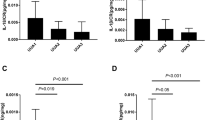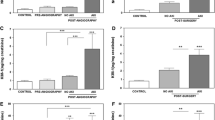Abstract
Aims/hypothesis
Kidney injury molecule 1 (KIM-1), liver fatty acid-binding protein (L-FABP), N-acetyl-β-d-glucosaminidase (NAG) and neutrophil gelatinase-associated lipocalin (NGAL) are urinary biomarkers of renal tubular injury. We examined their association with incident end-stage renal disease (ESRD) and all-cause mortality in American Indians with type 2 diabetes.
Methods
Biomarker concentrations were measured in baseline urine samples in 260 Pima Indians who were followed for a median of 14 years. HRs were reported per SD of creatinine (Cr)-normalised log-transformed KIM-1, NAG and NGAL, and for three categories of L-FABP.
Results
During follow-up, 74 participants developed ESRD and 101 died. Median concentrations of KIM-1/Cr, NAG/Cr and NGAL/Cr and the proportion of detectable L-FABP were highest in those with macroalbuminuria (p < 0.001 for KIM-1/Cr, NAG/Cr and L-FABP; p = 0.006 for NGAL/Cr). After multivariable adjustment, NGAL/Cr was positively associated with ESRD (HR 1.59, 95% CI 1.20, 2.11) and mortality (HR 1.39, 95% CI 1.06, 1.82); L-FABP/Cr was inversely associated with ESRD (HR [for highest vs lowest tertile] 0.40, 95% CI 0.19, 0.83). Addition of NGAL/Cr to models that included albuminuria and glomerular filtration rate increased the c-statistic for predicting ESRD from 0.828 to 0.833 (p = 0.001) and for death from 0.710 to 0.722 (p = 0.018). Addition of L-FABP/Cr increased the c-statistic for ESRD from 0.828 to 0.832 (p = 0.042).
Conclusions/interpretation
In Pima Indians with type 2 diabetes, urinary concentrations of NGAL and L-FABP are associated with important health outcomes, but they are unlikely to add to risk prediction with standard markers in a clinically meaningful way given the small increase in the c-statistic.



Similar content being viewed by others
Abbreviations
- ACE:
-
Angiotensin-converting enzyme
- Alb/Cr:
-
Urinary albumin-to-creatinine ratio
- CKD:
-
Chronic kidney disease
- Cr:
-
Creatinine
- ESRD:
-
End-stage renal disease
- GFR:
-
Glomerular filtration rate
- IDI:
-
Integrated discrimination improvement
- IQR:
-
Interquartile range
- KIM-1:
-
Kidney injury molecule 1
- L-FABP:
-
Liver fatty acid-binding protein
- LOD:
-
Limit of detection
- NAG:
-
N-acetyl-β-d-glucosaminidase
- NGAL:
-
Neutrophil gelatinase-associated lipocalin
- TRIBE-AKI:
-
Translation Research Investigating Biomarker Endpoints for Acute Kidney Injury
References
U.S. Renal Data System (2013) USRDS 2013 Annual data report: atlas of chronic kidney disease and end-stage renal disease in the United States. National Institutes of Health, National Institute of Diabetes and Digestive and Kidney Diseases, Bethesda, MD, USA
Araki S, Haneda M, Sugimoto T et al (2005) Factors associated with frequent remission of microalbuminuria in patients with type 2 diabetes. Diabetes 54:2983–2987
Perkins BA, Ficociello LH, Silva KH, Finkelstein DM, Warram JH, Krolewski AS (2003) Regression of microalbuminuria in type 1 diabetes. N Engl J Med 348:2285–2293
Pavkov ME, Knowler WC, Hanson RL, Bennett PH, Nelson RG (2008) Predictive power of sequential measures of albuminuria for progression to ESRD or death in Pima Indians with type 2 diabetes. Am J Kidney Dis 51:759–766
Gaede P, Tarnow L, Vedel P, Parving HH, Pedersen O (2004) Remission to normoalbuminuria during multifactorial treatment preserves kidney function in patients with type 2 diabetes and microalbuminuria. Nephrol Dial Transplant 19:2784–2788
Fioretto P, Mauer M, Brocco E et al (1996) Patterns of renal injury in NIDDM patients with microalbuminuria. Diabetologia 39:1569–1576
Nosadini R, Velussi M, Brocco E et al (2000) Course of renal function in type 2 diabetic patients with abnormalities of albumin excretion rate. Diabetes 49:476–484
Bolignano D, Lacquaniti A, Coppolino G et al (2009) Neutrophil gelatinase-associated lipocalin (NGAL) and progression of chronic kidney disease. Clin J Am Soc Nephrol 4:337–344
Nielsen SE, Sugaya T, Hovind P, Baba T, Parving HH, Rossing P (2010) Urinary liver-type fatty acid-binding protein predicts progression to nephropathy in type 1 diabetic patients. Diabetes Care 33:1320–1324
Nielsen SE, Andersen S, Zdunek D, Hess G, Parving HH, Rossing P (2011) Tubular markers do not predict the decline in glomerular filtration rate in type 1 diabetic patients with overt nephropathy. Kidney Int 79:1113–1118
von Eynatten M, Baumann M, Heemann U et al (2010) Urinary L-FABP and anaemia: distinct roles of urinary markers in type 2 diabetes. Eur J Clin Invest 40:95–102
Nielsen SE, Hansen HP, Jensen BR, Parving HH, Rossing P (2011) Urinary neutrophil gelatinase-associated lipocalin and progression of diabetic nephropathy in type 1 diabetic patients in a four-year follow-up study. Nephron Clin Pract 118:130–135
Vaidya VS, Niewczas MA, Ficociello LH et al (2011) Regression of microalbuminuria in type 1 diabetes is associated with lower levels of urinary tubular injury biomarkers, kidney injury molecule-1, and N-acetyl-β-d-glucosaminidase. Kidney Int 79:464–470
Nielsen SE, Reinhard H, Zdunek D et al (2012) Tubular markers are associated with decline in kidney function in proteinuric type 2 diabetic patients. Diabetes Res Clin Pract 97:71–76
Kim SS, Song SH, Kim IJ et al (2012) Clinical implication of urinary tubular markers in the early stage of nephropathy with type 2 diabetic patients. Diabetes Res Clin Pract 97:251–257
Fu WJ, Li BL, Wang SB et al (2012) Changes of the tubular markers in type 2 diabetes mellitus with glomerular hyperfiltration. Diabetes Res Clin Pract 95:105–109
Conway BR, Manoharan D, Manoharan D et al (2012) Measuring urinary tubular biomarkers in type 2 diabetes does not add prognostic value beyond established risk factors. Kidney Int 82:812–818
Liu KD, Yang W, Anderson AH et al (2013) Urine neutrophil gelatinase-associated lipocalin levels do not improve risk prediction of progressive chronic kidney disease. Kidney Int 83:909–914
Araki S, Haneda M, Koya D et al (2013) Predictive effects of urinary liver-type fatty acid-binding protein for deteriorating renal function and incidence of cardiovascular disease in type 2 diabetic patients without advanced nephropathy. Diabetes Care 36:1248–1253
O’Seaghdha CM, Hwang SJ, Larson MG, Meigs JB, Vasan RS, Fox CS (2013) Analysis of a urinary biomarker panel for incident kidney disease and clinical outcomes. J Am Soc Nephrol 24:1880–1888
Chou KM, Lee CC, Chen CH, Sun CY (2013) Clinical value of NGAL, L-FABP and albuminuria in predicting GFR decline in type 2 diabetes mellitus patients. PLoS One 8:e54863
Panduru NM, Forsblom C, Saraheimo M et al (2013) Urinary liver-type fatty acid-binding protein and progression of diabetic nephropathy in type 1 diabetes. Diabetes Care 36:2077–2083
Kamijo-Ikemori A, Sugaya T, Yasuda T et al (2011) Clinical significance of urinary liver-type fatty acid-binding protein in diabetic nephropathy of type 2 diabetic patients. Diabetes Care 34:691–696
Nelson RG, Bennett PH, Beck GJ et al (1996) Development and progression of renal disease in Pima Indians with non-insulin-dependent diabetes mellitus. N Engl J Med 335:1636–1642
Weil EJ, Fufaa G, Jones LI et al (2013) Effect of losartan on prevention and progression of early diabetic nephropathy in American Indians with type 2 diabetes. Diabetes 62:3224–3231
Myers BD, Nelson RG, Tan M et al (1995) Progression of overt nephropathy in non-insulin-dependent diabetes. Kidney Int 47:1781–1789
Pencina MJ, D’Agostino RB (2004) Overall C as a measure of discrimination in survival analysis: model specific population value and confidence interval estimation. Stat Med 23:2109–2123
Demler OV, Pencina MJ, D’Agostino RB Sr (2012) Misuse of DeLong test to compare AUCs for nested models. Stat Med 31:2577–2587
Pepe MS, Kerr KF, Longton G, Wang Z (2013) Testing for improvement in prediction model performance. Stat Med 32:1467–1482
Pencina MJ, D’Agostino RB Sr, D’Agostino RB Jr, Vasan RS (2008) Comments on integrated discrimination and net reclassification improvements: practical advice. Stat Med 27:207–212
Pencina MJ, D’Agostino RB, Pencina KM, Cecile A, Janssens JW, Greenland P (2012) Interpreting incremental value of markers added to risk prediction models. Am J Epidemiol 176:473–481
Thraikill KM, Moreau CS, Cockrell GE (2010) Disease and gender-specific dysregulation of NGAL and MMP-9 in type 1 diabetes mellitus. Endocrine 37:336–343
Meunier-Durmort C, Poirier H, Niot I, Forest C, Besnard P (1996) Up-regulation of the expression of the gene for liver fatty acid-binding protein by long-chain fatty acids. Biochem J 319:483–487
Kamijo A, Sugaya T, Hikawa A et al (2004) Urinary excretion of fatty-acid binding protein reflects stress overload on the proximal tubules. Am J Pathol 165:1243–1255
Coca SG, Garg AX, Thiessen-Philbrook H et al (2014) Urinary biomarkers of AKI and mortality 3 years after cardiac surgery. J Am Soc Nephrol 25:1063–1071
Tramontia G, Kanwar Y (2011) Tubular biomarkers to assess progression of diabetic nephropathy. Kidney Int 79:1042–1044
Xu S, Venge P (2000) Lipocalins as biochemical markers of disease. Biochim Biophys Acta 1482:298–307
Zoja C, Benigni A, Remuzzi G (2004) Cellular responses to protein overload: key event in renal disease progression. Curr Opin Nephrol Hypertens 13:31–37
Sharma SG, Bomback AS, Radhakrishnan J et al (2013) The modern spectrum of renal biopsy findings in patients with diabetes. Clin J Am Soc Nephrol 8:1718–1724
Helmersson-Karlqvist J, Larsson A, Carlsson AC et al (2013) Urinary neutrophil gelatinase-associated lipocalin (NGAL) is associated with mortality in a community-based cohort of older Swedish men. Atherosclerosis 227:408–413
Yoshikawa K, Adachi H, Hirai Y et al (2013) High serum N-acetyl-ß-d-glucosaminidase activity is a predictor of 28-year mortality in a population of community-dwelling Japanese-the Tanushimaru study. J Am Geriatr Soc 61:467–468
Jungbauer CG, Birner C, Jung B et al (2011) Kidney injury molecule-1 and N-acetyl-β-d-glucosaminidase in chronic heart failure: a possible biomarker of cardiorenal syndrome. Eur J Heart Fail 13:1104–1110
Sarnak MJ, Katz R, Newman A et al (2014) Association of urinary injury biomarkers with mortality and cardiovascular events. J Am Soc Nephrol 25:1545–1553
Han WK, Wagener G, Zhu Y, Wang S, Lee HT (2009) Urinary biomarkers in the early detection of acute kidney injury after cardiac surgery. Clin J Am Soc Nephrol 4:873–882
Nielsen SE, Schjoedt KJ, Astrup AS et al (2010) Neutrophil gelatinase-associated lipocalin (NGAL) and kidney injury molecule 1 (KIM1) in patients with diabetic nephropathy: a cross-sectional study and the effects of lisinopril. Diabet Med 27:1144–1150
Nielsen SE, Rossing K, Hess G et al (2012) The effect of RAAS blockade on markers of renal tubular damage in diabetic nephropathy: u-NGAL, u-KIM1 and u-LFABP. Scand J Clin Lab Invest 72:137–142
Acknowledgements
We thank Abbott Laboratories for supporting the measurement of urinary NGAL and CMIC for providing control materials for our studies. Abbott Laboratories and CMIC had no role in study design, data collection, data analysis, data interpretation or writing of the report. We also thank E. Cotter at University College Dublin, Dublin, Ireland for performing the urinary NGAL assays and M. J. Pencina at Duke University, Durham, NC, USA for his suggestions on how to assess the incremental value of markers added to risk prediction models. Parts of this study were presented in abstract form at the American Society of Nephrology annual meeting and scientific exposition in Atlanta, Georgia, 7–10 November 2013.
Funding
This work was supported by the Chronic Kidney Disease Biomarker Consortium funded by NIDDK U01DK85649, U01DK085673, U01DK085660, U01DK085688, U01DK085651 and U01DK085689, and by the Intramural Research Program of the National Institute of Diabetes and Digestive and Kidney Diseases.
Duality of interest
JVB appears as co-inventor on KIM-1 patents, which have been licensed by Partners Healthcare to a number of companies. He has received royalty income from Partners Healthcare. KDL had reagents donated for previous biomarker studies by Abbott and CMIC. All other authors declare that there is no duality of interest associated with their contribution to this manuscript.
Contribution statement
RGN, CyH, KDL, GDF, EJW, JVB and SSW designed the study with input into the study protocol from all authors. TEM, VS and JVB performed the biomarker assays. GDF, EJW, RGN, RLH, XZ and DX performed the statistical analyses. GDF, EJW, RGN and KDL drafted the manuscript and all authors assisted with revising it critically for important intellectual content. All authors contributed to the interpretation of the data and approved the final version. RGN is the guarantor of this work.
Author information
Authors and Affiliations
Consortia
Corresponding author
Additional information
Gudeta D. Fufaa and E. Jennifer Weil contributed equally to this paper.
Rights and permissions
About this article
Cite this article
Fufaa, G.D., Weil, E.J., Nelson, R.G. et al. Association of urinary KIM-1, L-FABP, NAG and NGAL with incident end-stage renal disease and mortality in American Indians with type 2 diabetes mellitus. Diabetologia 58, 188–198 (2015). https://doi.org/10.1007/s00125-014-3389-3
Received:
Accepted:
Published:
Issue Date:
DOI: https://doi.org/10.1007/s00125-014-3389-3




